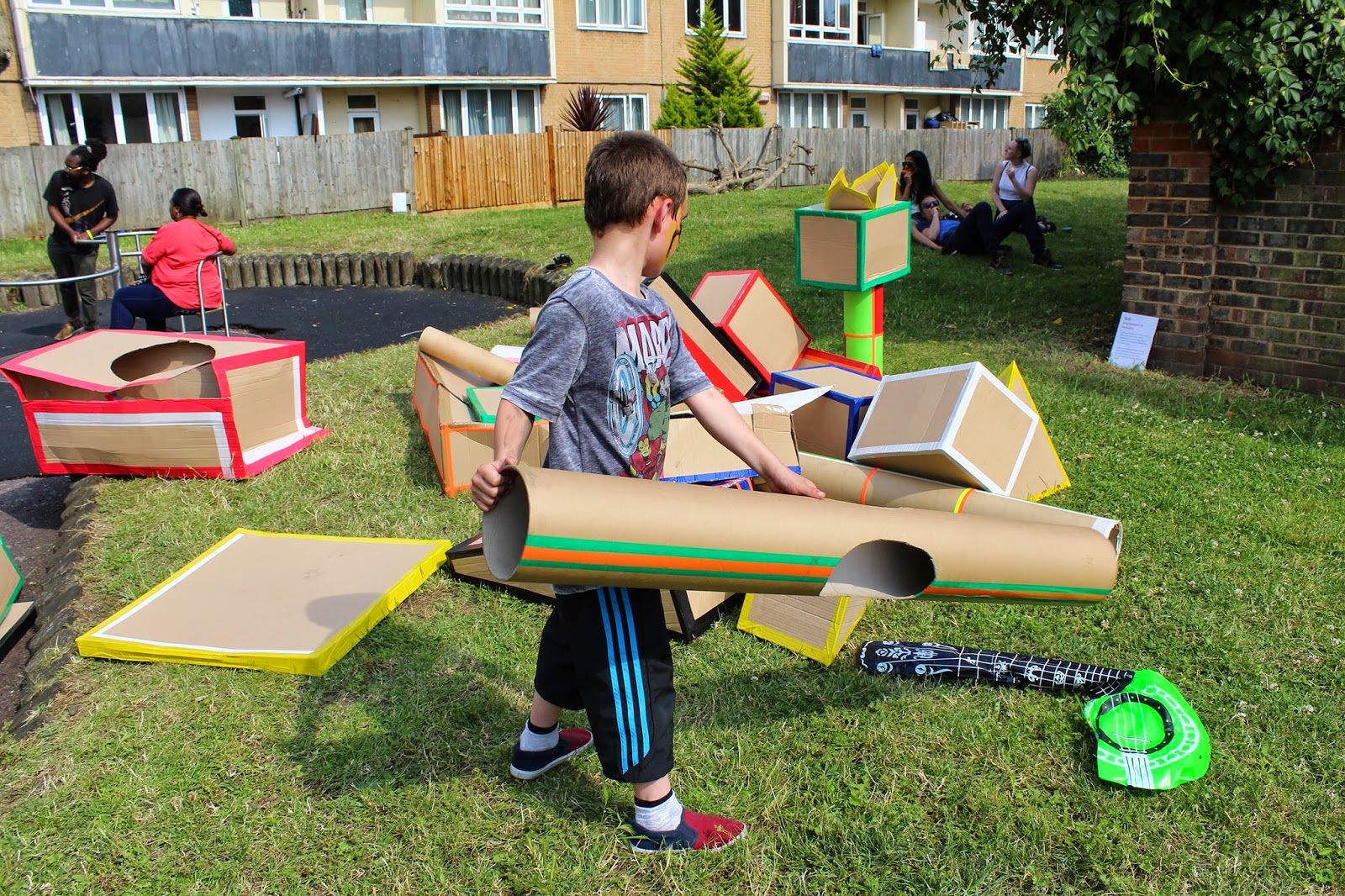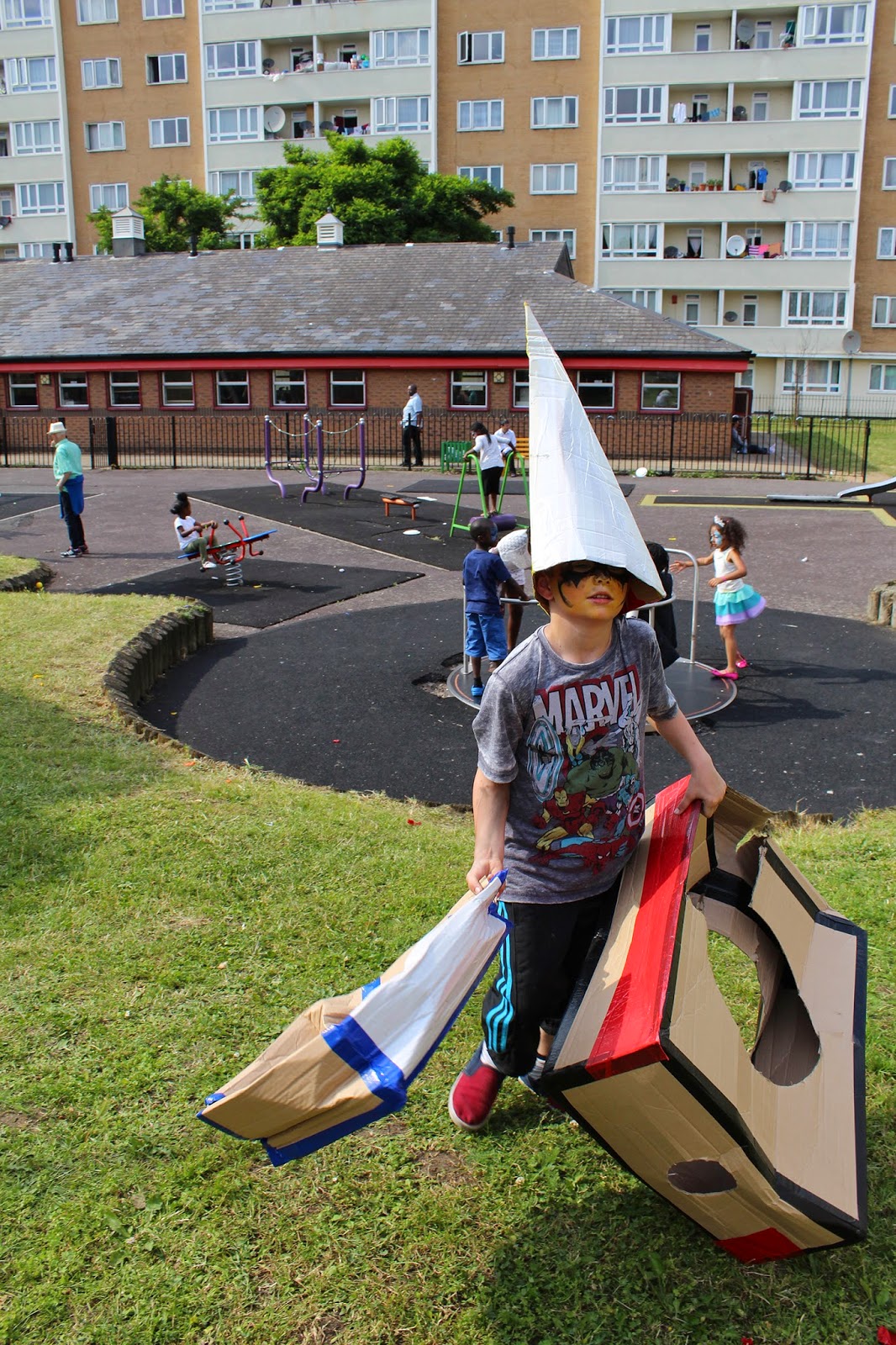The images in today's post are from an artist project by Shepherd Manyika. A seemingly simple intervention at a summer fun day on Pelican estate in Peckham that was full of interesting moments that highlight some of the complicated elements of being an adult in the world of supporting children's play.
Leading up to the event, Shepherd made forty cardboard sculptural objects. Each was different from the next and had it's own unique qualities. One might have had a cut out, one might be pointed, one you might be able to climb in, one might have balloons sticking out of it... All of this was done in the Shop of Possibilities, but none of this was done with children. This in itself was an interesting way of working for us, as more often than not, artist projects involve some sort of co-creation with the children. We may arrive with a trolley full of loose parts and see how the children and artists might put them together. This time the approach was different, and as reflected in the title 'How they Choose to Play with the Pieces' was all about what children might do with the artists work once it is made.
So we arrived on the estate at noon on a very sunny Saturday, looking quite ridiculous with trolleys and arms full of these colourful cardboard objects, and straight away drew a crowd.

The children were quite frantic in their initial explorations of the objects, moving from one to the other figuring out all the different pieces. There was a quick realisation that the pieces were more delicate than they looked, and whilst not exactly fragile, the children knew that these objects wouldn't last long if they jumped on them, and so they didn't. (Although popping the balloons happened straight away!) The the thing that set the tone straight away was how the artist and the team responded to this. And when asked excitedly by the children 'What are these for? What do we do with them?!' the answers they got were along the lines of 'We don't know yet, you can help us figure it out though!'
These unfamiliar objects became loose parts, the fascination moved away from what they were, to what they could be.
Loose parts naturally occur in playing and not only develop in the individual the capacity to symbolize but, when shared and involving others, create the transitional space, the to-ing and fro-ing of imaginations, through which meanings and relationships are formed.
- Chris Taylor: Playwork and the Theory of Loose Parts, from Foundations of Playwork, 2008
 |
| Using the pieces as building blocks |
 |
| Realising you can fit inside them |
 |
| Organising them |
 |
| Wearing them |
 |
| Re-organising them |
After an hour or so the initial rush calmed down and there were times when there was only one or two children using the pieces. This opened up a whole other level of enquiry as the child had less competition for the pieces and so could take their time exploring their different properties. This child went from wearing them...
To building with them...
To climbing inside them...
And then this funny little moment happened...
This was a tiny moment, but one that shows this child testing out an unfamiliar object and pushing it in different ways, not only to see what the object could and couldn't do but to test what she could and couldn't do.
We had families working together to build a fort...
Young children trying out the objects and moving them to other parts of the playground to see where they might fit best...
Then towards the end of the day, something happened that I was lucky to have seen first hand. There were no children playing with the objects, they were just strewn around the space, the artist and the playworkers were taking the opportunity to have a break. This meant that there was even more space around these objects because at that point they seemed to belong to nobody. A boy approached, he looked pretty wound up and started to kick the pieces around, clearly letting off some steam. I don't know how but a balloon had survived, so I handed it to the boy and said something along the lines of 'You can burst it if you like...' he silently took it from me, put it on the floor and jumped on top of it. It made that brilliant loud balloon popping sound and he looked up at me. 'Better?' I asked. He didn't say anything but gave me an almost smile, so I took that as a yes.
I walked away to give him space to choose where to go next, he started gathering the pieces and piling them up, over and over, focused and uninterrupted until every piece was arranged in a well balanced pile.
He was aware of me taking photographs, but chose to ignore me until he'd finished. At this point he stated that he wanted to get inside, and so he did. Seconds later, all the pieces came tumbling down as he stood up amongst all the cardboard...
He started to use one of the cardboard tubes to push and shove the other pieces around, and that must have been some sort of cue, because all of a sudden lots of other children appeared and started to do the same. Naturally a whole host of destructive play began to take unfold...
In this last half an hour, probably around 90% of the destruction took place, it seemed like the most appropriate way to end the play, with the pieces being flattened and destroyed. For us (the artist, gallery staff and playworkers) there was no predetermined outcome, no use for the objects beyond the session itself and no preciousness about what the children did with these things, and this made our roles feel different, like we approached the whole situation feeling more relaxed perhaps.
We often have or put pressures on ourselves, whether that be looking after a space or working towards an outcome, that can affect how we as adults choose to act amongst the children and their play. Shepherd's approach and cardboard pieces allowed us time and space to observe the natural flow of children coming and going and their actions. More importantly it allowed the children autonomy, room to make decisions for themselves about these objects which clearly had no predetermined use, 'real' function or preciousness to the adults who had brought them here.
Shepherd Manyika will be presenting 'How they Choose to Play with the Pieces' at the next Sunday Spot on Sunday 31 August from 2-4pm at the South London Gallery. It's free and suitable for children aged 3-12 years and their families. For more information please click here.








































No comments:
Post a Comment